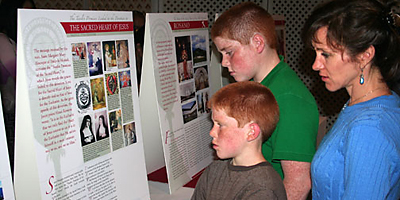
 TAYLORS—Signs proclaiming “Miracles Happen!” were posted around Prince of Peace Church campus Oct. 16 -17. Those words were an invitation for people to attend the Vatican International Exhibition of the Eucharistic Miracles of the World.
TAYLORS—Signs proclaiming “Miracles Happen!” were posted around Prince of Peace Church campus Oct. 16 -17. Those words were an invitation for people to attend the Vatican International Exhibition of the Eucharistic Miracles of the World.
Organizers reported more than 800 people flowed through the exhibit in a silent, steady stream to see items such as panels depicting the 126 miracles associated with the Blessed Sacrament.
In addition to Prince of Peace and other upstate Catholic parishes, people came from Rock Hill, Columbia and Charlotte. They came in groups, families, individually, and from different faiths, whether infant or octogenarian. Some stayed for hours, pausing to take pictures and stepping away in prayer. Some returned several times.
Barrie Jean Dursse, from Prince of Peace, said she invited her parents, who are not Catholic, to see what prompts her love for the Lord in the Blessed Sacrament. After seeing the exhibit, her father commented on how impressed he was with the way the church has preserved its history of Eucharistic miracles. Her mother told Dursse that she now has a better understanding of what her daughter has been trying to communicate about the real presence.
In his homilies that weekend, Msgr. Steven L. Brovey referenced the recent U.S. Religious Knowledge Survey by the Pew Forum on Religion & Public Life, which revealed that a mere 55 percent of U.S. Catholics correctly identified church teaching on transubstantiation.
The pastor said God gives us blessings to help bolster and sustain the faith of the church during times of crisis and doubt.
Msgr. Brovey highlighted the first eucharistic miracle, which occurred in Lanciano, Italy, around the year 700 when a Basilian monk celebrated Mass at St. Legontian. Though he was having doubts about the real presence, he celebrated Mass. During the consecration, the priest saw the bread change into living flesh and the wine change into blood, which coagulated into five globules corresponding with the number of Christ’s wounds.
According to www.therealpresence.org, various ecclesiastical investigations have been conducted since then.
From 1970-1971 and again in 1981, a scientific investigation was led by Odoardo Linoli, a professor in anatomy, pathological histology, chemistry and clinical microscopy. His analyses concluded that the flesh and blood are real, and belong to the human species.
Linoli’s tests also determined that the flesh consists of the muscular tissue of the human heart and the blood is type AB, identical to the blood found on the Shroud of Turin.
Msgr. Brovey’s remarks touched parishioners, as was evidenced when one lady visited the exhibit on Sunday afternoon and asked to be directed to “that miracle monsignor talked about at Mass this morning.”
Perhaps she had a conversion experience like a pilgrim who visited Lanciano, who was reported to have remarked, “I never believed in the physical presence of Jesus in the Eucharist. To me, it was strictly ‘in memory of Him’. Now, I truly believe that my Jesus comes alive to me personally in the consecrated host that I consume at holy Mass.”
Mary Cockfield, who made a pilgrimage to Lanciano, said that exhibit panel gave an accurate description of what she saw. The Midlands visitor said it would be impossible to view the exhibit and not have one’s faith increase.
Ryan Adams, a member of Prince of Peace, said seeing the exhibit opened his heart to other miracles of the church.
